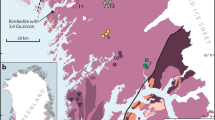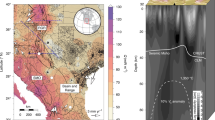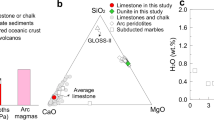Abstract
The rock record and geochemical evidence indicate that continental recycling has been occurring since the early history of the Earth. The stabilization of felsic continents in place of Earth’s early mafic crust about 3.0 to 2.0 billion years ago, perhaps due to the initiation of plate tectonics, implies widespread destruction of mafic crust during this time interval. However, the physical mechanisms of such intense recycling on a hotter, (late) Archaean and presumably plate-tectonic Earth remain largely unknown. Here we use thermomechanical modelling to show that extensive recycling via lower crustal peeling-off (delamination but not eclogitic dripping) during continent–continent convergence was near ubiquitous during the late Archaean to early Proterozoic. We propose that such destruction of the early mafic crust, together with felsic magmatism, may have caused both the emergence of silicic continents and their subsequent isostatic rise, possibly above the sea level. Such changes in the continental character have been proposed to influence the Great Oxidation Event and, therefore, peeling-off plate tectonics could be the geodynamic trigger for this event. A transition to the slab break-off controlled syn-orogenic recycling occurred as the Earth aged and cooled, leading to reduced recycling and enhanced preservation of the continental crust of present-day composition.
This is a preview of subscription content, access via your institution
Access options
Access Nature and 54 other Nature Portfolio journals
Get Nature+, our best-value online-access subscription
$29.99 / 30 days
cancel any time
Subscribe to this journal
Receive 12 print issues and online access
$259.00 per year
only $21.58 per issue
Buy this article
- Purchase on Springer Link
- Instant access to full article PDF
Prices may be subject to local taxes which are calculated during checkout




Similar content being viewed by others
References
Armstrong, R. L. & Harmon, R. S. Radiogenic isotopes: the case for crustal recycling on a near-steady-state no-continental-growth Earth [and discussion]. Phil. Trans. R. Soc. Lond. A 301, 443–472 (1981).
Bowring, S. & Housh, T. The Earth’s early evolution. Science 269, 1535–1540 (1995).
Dhuime, B., Hawkesworth, C. J., Cawood, P. A. & Storey, C. D. A change in the geodynamics of continental growth 3 billion years ago. Science 335, 1334–1336 (2012).
Cawood, P. A., Hawkesworth, C. J. & Dhuime, B. The continental record and the generation of continental crust. Bull. Geol. Soc. Am. 125, 14–32 (2013).
Rudnick, R. L. Making continental crust. Nature 378, 571–578 (1995).
Kay, R. W. & Mahlburg-Kay, S. Creation and destruction of lower continental crust. Geol. Rundsch. 80, 259–278 (1991).
Willbold, M. & Stracke, A. Formation of enriched mantle components by recycling of upper and lower continental crust. Chem. Geol. 276, 188–197 (2010).
Belousova, E. A. et al. The growth of the continental crust: constraints from zircon Hf-isotope data. Lithos 119, 457–466 (2010).
Kamber, B. S., Whitehouse, M. J., Bolhar, R. & Moorbath, S. Volcanic resurfacing and the early terrestrial crust: zircon U–Pb and REE constraints from the Isua Greenstone Belt, southern West Greenland. Earth Planet. Sci. Lett. 240, 276–290 (2005).
Dhuime, B., Wuestefeld, A. & Hawkesworth, C. J. Emergence of modern continental crust about 3 billion years ago. Nat. Geosci. 8, 552–555 (2015).
Tang, M., Chen, K. & Rudnick, R. L. Archean upper crust transition from mafic to felsic marks the onset of plate tectonics. Science 351, 372–375 (2016).
Lee, C. T. A. et al. Two-step rise of atmospheric oxygen linked to the growth of continents. Nat. Geosci. 9, 417–424 (2016).
Martin, H. & Moyen, J. F. Secular changes in tonalite-trondhjemite-granodiorite composition as markers of the progressive cooling of Earth. Geology 30, 319–322 (2002).
Laurent, O., Martin, H., Moyen, J. F. & Doucelance, R. The diversity and evolution of late-Archean granitoids: evidence for the onset of ‘modern-style’ plate tectonics between 3.0 and 2.5 Ga. Lithos 205, 208–235 (2014).
Jacobsen, S. B. Isotopic and chemical constraints on mantle-crust evolution. Geochim. Cosmochim. Acta 52, 1341–1350 (1988).
Johnson, T. E., Brown, M., Kaus, B. J. & VanTongeren, J. A. Delamination and recycling of Archaean crust caused by gravitational instabilities. Nat. Geosci. 7, 47–52 (2013).
Herzberg, C., Condie, K. & Korenaga, J. Thermal history of the Earth and its petrological expression. Earth Planet. Sci. Lett. 292, 79–88 (2010).
Korenaga, J. Initiation and evolution of plate tectonics on Earth: theories and observations. Annu. Rev. Earth Planet. Sci. 41, 117–151 (2013).
Brown, M. Duality of thermal regimes is the distinctive characteristic of plate tectonics since the Neoarchean. Geology 34, 961–964 (2006).
van Hunen, J. & Moyen, J. F. Archean subduction: fact or fiction? Annu. Rev. Earth Planet. Sci. 40, 195–219 (2012).
Sizova, E., Gerya, T., Stüwe, K. & Brown, M. Generation of felsic crust in the Archean: a geodynamic modeling perspective. Precambrian Res. 271, 198–224 (2015).
Clift, P. D., Vannucchi, P. & Morgan, J. P. Crustal redistribution, crust-mantle recycling and Phanerozoic evolution of the continental crust. Earth-Sci. Rev. 97, 80–104 (2009).
Scholl, D. W. & von Huene, R. Implications of estimated magmatic additions and recycling losses at the subduction zones of accretionary (non-collisional) and collisional (suturing) orogens. Geol. Soc. Lond. Spec. Publ. 318, 105–125 (2009).
Stern, R. J. & Scholl, D. W. Yin and yang of continental crust creation and destruction by plate tectonic processes. Int. Geol. Rev. 52, 1–31 (2010).
Sizova, E., Gerya, T. & Brown, M. Contrasting styles of Phanerozoic and Precambrian continental collision. Gondwana Res. 25, 522–545 (2014).
van Hunen, J. & van den Berg, A. P. Plate tectonics on the early Earth: limitations imposed by strength and buoyancy of subducted lithosphere. Lithos 103, 217–235 (2008).
Chardon, D., Gapais, D. & Cagnard, F. Flow of ultra-hot orogens: a view from the Precambrian, clues for the Phanerozoic. Tectonophysics 477, 105–118 (2009).
Cagnard, F., Barbey, P. & Gapais, D. Transition between ‘Archaean-type’ and ‘modern-type’ tectonics: insights from the Finnish Lapland Granulite Belt. Precambrian Res. 187, 127–142 (2011).
Magni, V., Faccenna, C., Van Hunen, J. & Funiciello, F. Delamination vs. break-off: the fate of continental collision. Geophys. Res. Lett. 40, 285–289 (2013).
van Hunen, J. & Allen, M. B. Continental collision and slab break-off: a comparison of 3-D numerical models with observations. Earth Planet. Sci. Lett. 302, 27–37 (2011).
Duretz, T., Gerya, T. V. & May, D. A. Numerical modelling of spontaneous slab breakoff and subsequent topographic response. Tectonophysics 502, 244–256 (2011).
Wu, Y., Fei, Y., Jin, Z. & Liu, X. The fate of subducted upper continental crust: an experimental study. Earth Planet. Sci. Lett. 282, 275–284 (2009).
Herzberg, C. et al. Temperatures in ambient mantle and plumes: constraints from basalts, picrites, and komatiites. Geochem. Geophys. Geosyst. 8, Q02006 (2007).
Hildebrand, R. S. & Bowring, S. A. Crustal recycling by slab failure. Geology 27, 11–14 (1999).
Faryad, S. W., Kachlík, V., Sláma, J. & Jedlicka, R. Coincidence of gabbro and granulite formation and their implication for Variscan HT metamorphism in the Moldanubian Zone (Bohemian Massif), example from the Kutná Hora Complex. Lithos 264, 56–69 (2016).
von Blanckenburg, F. et al. The origin of Alpine plutons along the Periadriatic Lineament. Schweiz. Mineral. Petrogr. Mitt. 78, 55–66 (1998).
Webb, A. A. G. et al. The Himalaya in 3D: slab dynamics controlled mountain building and monsoon intensification. Lithosphere L636-1 (2017).
Bird, P. Continental delamination and the Colorado Plateau. J. Geophys. Res. Solid Earth 84, 7561–7571 (1979).
Gerya, T. Precambrian geodynamics: concepts and models. Gondwana Res. 25, 442–463 (2014).
Faccenda, M., Minelli, G. & Gerya, T. V. Coupled and decoupled regimes of continental collision: numerical modeling. Earth Planet. Sci. Lett. 278, 337–349 (2009).
Dewey, J. F. Orogeny can be very short. Proc. Natl Acad. Sci. USA 102, 15286–15293 (2005).
Condie, K. Accretionary orogens in space and time. Geol. Soc. Am. Memoirs 200, 145–158 (2007).
Condie, K. Preservation and recycling of crust during accretionary and collisional phases of Proterozoic orogens: a bumpy road from Nuna to Rodinia. Geosciences 3, 240–261 (2013).
Moyen, J. F. & Stevens, G. in Archean Geodynamics and Environments (eds Benn, K., Mareschal, J.-C. & Condie, K. C.) 149–175 (American Geophysical Union, 2006).
Kump, L. R. & Barley, M. E. Increased subaerial volcanism and the rise of atmospheric oxygen 2.5 billion years ago. Nature 448, 1033–1036 (2007).
Campbell, I. H. & Davies, D. R. Raising the continental crust. Earth Planet. Sci. Lett. 460, 112–122 (2017).
Lee, C. T. A. Treatise on Geochemistry Vol. 4, 2nd edn, 423–456 (Elsevier, 2014).
Stern, R. J. Evidence from ophiolites, blueschists, and ultrahigh-pressure metamorphic terranes that the modern episode of subduction tectonics began in Neoproterozoic time. Geology 33, 557–560 (2005).
Furnes, H., de Wit, M., Staudigel, H., Rosing, M. & Muehlenbachs, K. A vestige of Earth’s oldest ophiolite. Science 315, 1704–1707 (2007).
Gerya, T. V. Introduction to Numerical Geodynamic Modelling (Cambridge Univ. Press, 2010).
Gerya, T. V. & Yuen, D. A. Robust characteristics method for modelling multiphase visco-elasto-plastic thermo-mechanical problems. Phys. Earth Planet. Inter. 163, 83–105 (2007).
Schmeling, H. et al. A benchmark comparison of spontaneous subduction models—towards a free surface. Phys. Earth Planet. Inter. 171, 198–223 (2008).
Turcotte, D. L. & Schubert, G. Geodynamics (Cambridge Univ. Press, 2002).
Ranalli, G. Rheology of the Earth 2nd edn (Chapman Hall, 1995).
Kameyama, M., Yuen, D. A. & Karato, S.-I. Thermal-mechanical effects of low-temperature plasticity (the Peierls mechanism) on the deformation of a viscoelastic shear zone. Earth Planet. Sci. Lett. 168, 159–172 (1999).
Evans, B. & Goetze, C. The temperature variation of hardness of olivine and its implication for polycrystalline yield stress. J. Geophys. Res. 84, 5505–5524 (1979).
Kocks, U. F., Argon, A. S. & Ashby, M. F. Thermodynamics and kinetics of slip. Progress Mater. Sci. 19, 1–281 (1975).
Connolly, J. A. D. Computation of phase equilibria by linear programming: a tool for geodynamic modeling and its application to subduction zone decarbonation. Earth Planet. Sci. Lett. 236, 524–541 (2005).
Gerya, T. V., Connolly, J. A. D., Yuen, D. A., Gorczyk, W. & Capel, A. M. Seismic implications of mantle wedge plumes. Phys. Earth Planet. Inter. 156, 59–74 (2006).
Mishin, Y. A., Gerya, T. V., Burg, J.-P. & Connolly, J. A. D. Dynamics of double subduction: numerical modeling. Phys. Earth Planet. Inter. 171, 280–295 (2008).
Gerya, T. V., Yuen, D. A. & Maresch, W. V. Thermomechanical modelling of slab detachment. Earth Planet. Sci. Lett. 226, 101–116 (2004).
Baumann, C., Gerya, T. V. & Connolly, J. A. D. Numerical modelling of spontaneous slab breakoff dynamics during continental collision. Geol. Soc. Lond. Spec. Publ. 332, 99–114 (2010).
Burg, J.-P. & Gerya, T. V. The role of viscous heating in Barrovian metamorphism of collisional orogens: thermomechanical models and application to the Lepontine Dome in the Central Alps. J. Metamorph. Geol. 23, 75–95 (2005).
Clauser, C. & Huenges, E. in Rock Physics and Phase Relations: A Handbook of Physical Constants (ed. Ahrens, T. J.) 105–126 (American Geophysical Union, 1995).
Hess, P. C. Origin of Igneous Rocks (Harvard Univ. Press, 1989).
Schmidt, M. W. & Poli, S. Experimentally based water budgets for dehydrating slabs and consequences for arc magma generation. Earth Planet. Sci. Lett. 163, 361–379 (1998).
Acknowledgements
P.C. is funded by the Deutscher Akademischer Austauschdienst (Funding ID-57076385) and operating grants from Ruhr-Universität Bochum. T.G. received support from the ERC ITN projects SUBITOP (604713) and ZIP (674899) as well as from SNF projects Swiss-AlpArray (CRSII2_154434) and number 200020_166063. S.C. is funded by operating grants from Ruhr-Universität Bochum. Simulations were performed on the ETH-Zurich Brutus and Euler clusters.
Author information
Authors and Affiliations
Contributions
S.C. and T.G. conceived the study. P.C. designed the study together with S.C. and T.G. P.C. conducted the numerical experiments, interpreted the results and formulated the MATLAB codes for calculating recycled volumes and post processing the numerical results. T.G. designed the 2D-thermomechanical code. All authors discussed the results, problems and methods, interpretation of the results, and participated in writing the paper.
Corresponding author
Ethics declarations
Competing interests
The authors declare no competing financial interests.
Supplementary information
Supplementary Information
Supplementary Information (PDF 5934 kb)
Rights and permissions
About this article
Cite this article
Chowdhury, P., Gerya, T. & Chakraborty, S. Emergence of silicic continents as the lower crust peels off on a hot plate-tectonic Earth. Nature Geosci 10, 698–703 (2017). https://doi.org/10.1038/ngeo3010
Received:
Accepted:
Published:
Issue Date:
DOI: https://doi.org/10.1038/ngeo3010
This article is cited by
-
Mechanisms to generate ultrahigh-temperature metamorphism
Nature Reviews Earth & Environment (2023)
-
Intracontinental lithospheric delamination: Constraints from imaging the mantle transition zone beneath the southwestern part of the Sichuan Basin
Science China Earth Sciences (2023)
-
Venus, the Planet: Introduction to the Evolution of Earth’s Sister Planet
Space Science Reviews (2023)
-
The Habitability of Venus
Space Science Reviews (2023)
-
Reconstructing Earth’s atmospheric oxygenation history using machine learning
Nature Communications (2022)



